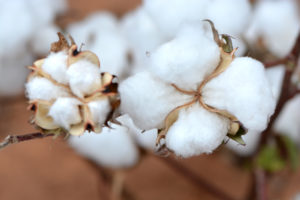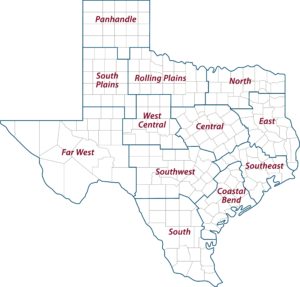Texas Planted Cotton Acres Projected Flat to Slightly Up
Planted cotton acres are expected to be flat or up slightly as the growing season nears, said a Texas A&M AgriLife Extension Service expert.
Texas cotton acres were expected to remain around 8 million acres for the 2019 growing season. (Texas A&M AgriLife photo by Kay Ledbetter)
Dr. Gaylon Morgan, AgriLife Extension statewide cotton specialist, College Station, said Texas cotton specialists around the state expect acreage to remain static in most areas. They agree good soil moisture profiles, wet conditions delaying corn and sorghum plantings and better pricing incentives could drive an increase.
Morgan said Cotton Grower magazine, a national trade publication for growers, forecast Texas acreage to fall 500,000 acres to 7.2 million compared to 7.7 million last year.
“There’s a lot of time before the planting window closes for regions that are dealing with saturated soils, so we expect cotton will go in on those acres,” he said. “And there could be even more than expected if producers can’t get corn or sorghum planted. In other regions, the low grain commodity prices and poor performing wheat could also drive an increase.”
In the Rio Grande Valley, Morgan said producers have good soil moisture profiles and were expected to begin planting cotton toward the end of the month. Cotton acres may increase a little, but there are limitations due to crop rotation restrictions.
“They’re pretty much maxed out around 220,000 acres,” he said. “There will be plenty of corn and sorghum going in soon and those cotton acres will follow soon after, depending on soil temperatures.”
In the Coastal Bend, cotton acres are expected to remain steady after four years of increased planting, but could be up due to excessive moisture, Morgan said.
“We will likely see a 5-10 percent increase in the Upper Gulf Coast region, especially knowing how wet things are now and how many fields have not been worked and prepared for grain planting,” he said.
Morgan expects another double-digit increase in acreage in the Blacklands region following an increase last year.
“Again, you’ve got other commodities prices that are low, inability to plant wheat in the fall and increased ginning capacity that weren’t there a few years ago,” he said. “Cotton could be more attractive to those growers, and conditions are set up very well for the dryland crop. The soil moisture profile is at a point to where the crop should perform fine even if we received just one well-timed rain in the summer.”
AgriLife Extension district reporters compiled the following summaries:
CENTRAL: Temperatures were warmer. Fields were dry enough to prepare for corn planting. Pecan harvest neared completion in most orchards. Pastures were in bad condition with no growth. Hay supplies were short across the district, but livestock were in fair to good condition. Farmers were not able to access fields to prepare for spring planting due to wet conditions. Conditions were also causing difficulties for producers needing to feed or move cattle. Fruit and ornamental trees were beginning to bloom due to mild weather. Nearly all counties reported good soil moisture and good rangeland and pasture conditions overall.
ROLLING PLAINS: Weather was cooler and drier, but forecasts called for moisture. Irrigated wheat acres were in good condition, but dryland acres needed rain as soil moisture levels were dwindling quickly. The cotton harvest was better than expected for some producers, while others were still harvesting. Pasture and rangeland were in fair to good condition. Producers continued to feed supplements and hay on a small scale.
COASTAL BEND: Extreme wet conditions continued. Most producers were behind on tillage and field preparation for spring planting. If fields dry out soon, corn planting should begin in two to three weeks. There were isolated fields with cotton still on the stalk. Warmer weather allowed volunteer winter forages to emerge. Winter rye, oats and wheat emerged, but growth was stunted by excessive moisture. Stock ponds were full. Hay and supplemental feeding continued, and livestock were in good condition.
EAST: Wet conditions continued to cause problems across the district. Trinity and Jasper counties reported flooding. Pasture and rangeland conditions were poor to very poor in Shelby, Trinity, Anderson, Sabine, Marion, Cherokee and Rusk counties. Most other counties reported fair to good pasture and rangeland conditions. Subsoil and topsoil conditions were divided between adequate and surplus throughout the district. Temperatures ranged from freezing to 70 degrees in San Augustine County, with heavy fog and light precipitation. Winter pastures were not growing and forced producers to feed excessive amounts of hay. Producers were running short on hay in Anderson, Cherokee, Shelby, Sabine and Trinity counties. Hay in Cherokee County was being brought in from as far away as Mississippi and Alabama. Anderson County had hay costs as high as $75 to $110 per round bale. Trinity County had some cattle herd liquidations due to the hay shortage. Anderson County producers could not access bottomlands due to soil saturation. Some plowing on hillsides allowed for watermelon planting preparation. Houston County cattle numbers were down at the sale barn, but prices were up. Shelby County had good numbers at the sale barn with prices holding steady. Cattle body condition scores in Anderson County were 3 to 7. Wild hogs damaged pastures and yards.
SOUTH PLAINS: Subsoil and topsoil moisture levels were very low. Dry, windy conditions made pasture, rangeland and winter wheat conditions poor to fair. Winter wheat was supplemented with irrigation. Producers were preparing for spring planting. Cattle were in good condition.
PANHANDLE: The district was dry, and no moisture was received. Dry conditions hurt wheat and pasture progress, and the district was desperate for rainfall or snow. Cattle conditions declined without supplemental feed. Producers started irrigating wheat in the hopes of producing forage. Dryland wheat was spotty at best, with many areas yet to emerge. The cotton crop was harvested, but many modules were still sitting in the turn rows.
NORTH: Soil moisture was mostly adequate. Daytime temperatures increased to the upper 60s. Pastures were drying but soils were still very wet. Some counties reported standing water in areas, and lowland pastures and hay fields were inaccessible since fall. Some counties reported conditions dried enough for farmers to access fields and finish planting wheat and oats intended for fall. The few producers lucky enough to get their wheat in early were able to put some stocker calves on it, but stocking rates were lower than usual. All other producers had little to no grazing because wheat and oats were either in saturated soil or drowning in water. Drier conditions helped some winter crops improve, but rain was in the forecast. Livestock were in good condition, though some were looking poor. Hay shortages continued, and producers were feeding a lot of hay and providing supplements. Some calving occurred.
FAR WEST: Temperature were in the mid-70s with lows in the mid-20s. Little to no measurable rainfall was reported by most of the district. Moisture conditions were good due to significant fall rains. Some playa lakes that typically recede were likely to remain and prevent cotton planting. The wheat crop was beginning to break dormancy. Nitrogen leaching was evident where water stood for several days. Fieldwork picked up since topsoil dried enough. Weed pressure was high in many fields.
WEST CENTRAL: The growing season was off to a good start with a full soil moisture profile and stock tanks filled to the brim. Cool-season annuals were providing grazing in pastures with producers supplementing some protein. Wheat/oat pastures looked good and most provided grazing for livestock. Cattle prices were $5-$10 higher per hundredweight on all classes of cattle.
SOUTHEAST: Excess soil moisture was reported around the district. In Grimes County, based on clientele feedback, soil compaction and soil erosion were issues throughout the county. Burleson County reported 40 percent of their cotton crop remained in fields and would not be ginned. Soil moisture conditions were preventing preparations for planting. Rangeland and pasture ratings were excellent to very poor with poor being most common.
SOUTHWEST: Most counties reported wet conditions. Farmers waited for warmer, drier conditions to prepare fields for planting and fertilization. Rangeland and pasture conditions were good. Supplemental feeding of livestock continued.
SOUTH: Western and northern parts of the district reported mild weather and short to adequate soil moisture levels. Eastern and southern parts reported cooler weather, some rainfall and adequate soil moisture levels. Kleberg and Kennedy counties reported 2 inches of rainfall over the past two reporting periods. Potato planting was in full swing. Wheat fields continued to develop and were in good to excellent condition. Pasture and rangeland conditions were fair to poor, and livestock supplemental feeding continued. Wheat and oat fields looked good in some areas. In McMullen County, range and pasture conditions remained mostly in fair condition. Good soil moisture conditions were good for winter annual forb and grass growth, which will help offset some winter supplementation. Spring calving season was picking up. Body condition scores on cattle remained fair. Coastal Bermuda grass fields were dormant, and crop farmers were preparing seed beds and soil for the growing season. In Zavala County, cabbage and spinach harvests were very active. Producers with irrigation were watering wheat fields. Prices at local beef cattle markets started a steady climb. Cull cow prices continued to drag the bottom and needed to rebound. Duval County reported the pasture and range conditions were doing well, as were winter crops due to adequate rainfall. Oat pastures looked good. Ranchers and deer breeders were supplementing their livestock and wildlife.
Source: Texas AgriLife Extension


